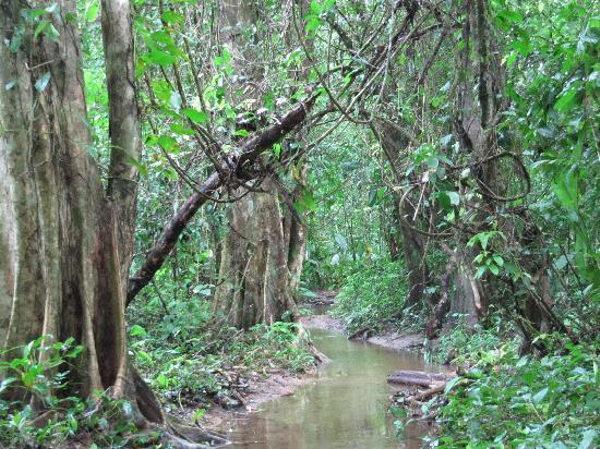Puntarenas, Puntarenas, Costa Rica
Suggest Place to Visit
1345
Track to location with GPS |
 |
It is considered a very important piece in the country's extensive system of national parks and biological reserves. The biological diversity is amazing. National Geographic has called it "the most intense place in the world, biologically speaking" and it is estimated that no place in the world (which has a similar extent) is home to greater biological diversity. Anyone wishing to visit you must be prepared for many things.
This park preserves the largest primary forest in the American Pacific, along with one of the few sizable remnants of rainforest in the world. Logging is usually done in this forest because it is an accessible place that contains large and valuable trees. However, these habitats are the richest, biologically speaking. Thus, while about half of the earth's moist tropical forests still remain, what remains of them is often not sufficient to sustain the original biodiversity. In particular, large animals need a large habitat.
The corcovado, however, is large enough to support important populations of tapir (Tapirus bairdii) (also called danta), jaguar (Panthera onca) and mountain pig (Tayassu pecari), species considered endangered. contain 140 mammalian species (representing 10% of the mammalian species on the American continent).
Costa Rica itself is considered an ideal place for ornithologists and the Corcovado contains several hundred bird species. Recently, the harpy, considered extinct in the area since 1989, has been identified in the park.
The abundance of wildlife can be partly explained by the varied vegetation, of which there are 13 types including mountain forest (covering more than half of the park), mangrove, prairie forest, floodplain forest, swamp forest and others, which together contain 500 tree species, such as the spacable. Another reason for diversity (which applies to the rest of the country) is that it is located in a biological corridor of flora and fauna.
Corcovado National Park is located on the Osa Peninsula, southwest of Costa Rica (9 ° North, 83 ° West) and is part of the Osa Conservation Area. It was established on October 24, 1975 and comprises an area of 45757 hectares of land and 5375 hectares of sea.
The park is open to the public, but reservations are required. This can be done in Puerto Jiménez, on the east coast of the peninsula. You can camp or stay in hotels, and meals are served, but must be notified a week in advance. Keep in mind that researchers have priority over other visitors, although there is usually enough space and facilities for both groups. Some hotels in the region have private biological reserves in the Corcovado area. Among them, one of the 36.5 hectares that borders the Corcovado National Park
There are 2 main paths, one that runs along the coast and one inland, and 4 ranger stations where you can spend the night: 3 at the park entrances and 1 where the paths intersect. One runs from northwest to southeast near the ocean, with Sirena station about halfway, from where the other way to Los Patos station, at the eastern end of the park, leaves.
You can fly inside the park (arriving at Sirena station), from where small trails depart. For a walk in the park, an acceptable physical condition is recommended, be 2 or 3 days (at least), plan routes in advance and of course caution. Between July and November, some sections of the park may be closed to the public due to rainfall.
In the path that runs along the sea, it must be taken into account that rivers must be passed and that if they are very high they cannot be crossed on foot, so it is important to consider the tides. This information can be obtained from Puerto Jiménez. Most of this path occurs on the beach, which implies heat and salt air, and there are few sources of drinking water; therefore, when packing, you should take plenty to avoid dehydration.
In addition, it should be noted that there are crocodiles in the rivers and at high tide there are even sharks that swim to the estuary for food.
Most animal sightings occur on the beach path where you can see macaws, hermit crab, pelicans fishing in the sea, spider monkeys (you need to be careful with urine), anteater, white-faced monkeys (capuchins), pica -peck or coatis, to name a few. With a little luck, you can see a tapir, although these are nocturnal animals. Tapirs are striking animals (it is recommended to use flashlights if night vision) and harmless if undisturbed.
Comments
We don´t have yet any comments about:
Corcovado National Park, Costa Rica
Corcovado National Park, Costa Rica
Be the first to leave a comment as it is very important to inform other people
Outros locais a visitar
Within a radius of 20 km from:Corcovado National Park, Costa Rica
Unfortunately we do not have information on other places to visit in this area yet
Hotel reservation near Corcovado National Park, Costa Rica within a radius of 20 km
Why to book with
The best prices
Our partnerships with the world´s largest operators offer research on the best market prices.
More options
At Rotas Turisticos you can book the hotel, buy the air ticket, book the transfer from the airport to the hotel and vice versa, book the local excursions, rent the car, take travel insurance and consult the places to visit and where to go.
Holiday Tips & Destinations
Hundreds of holiday destinations with all the options that allow you to easily choose the destination that best suits your dream vacation.
Links






